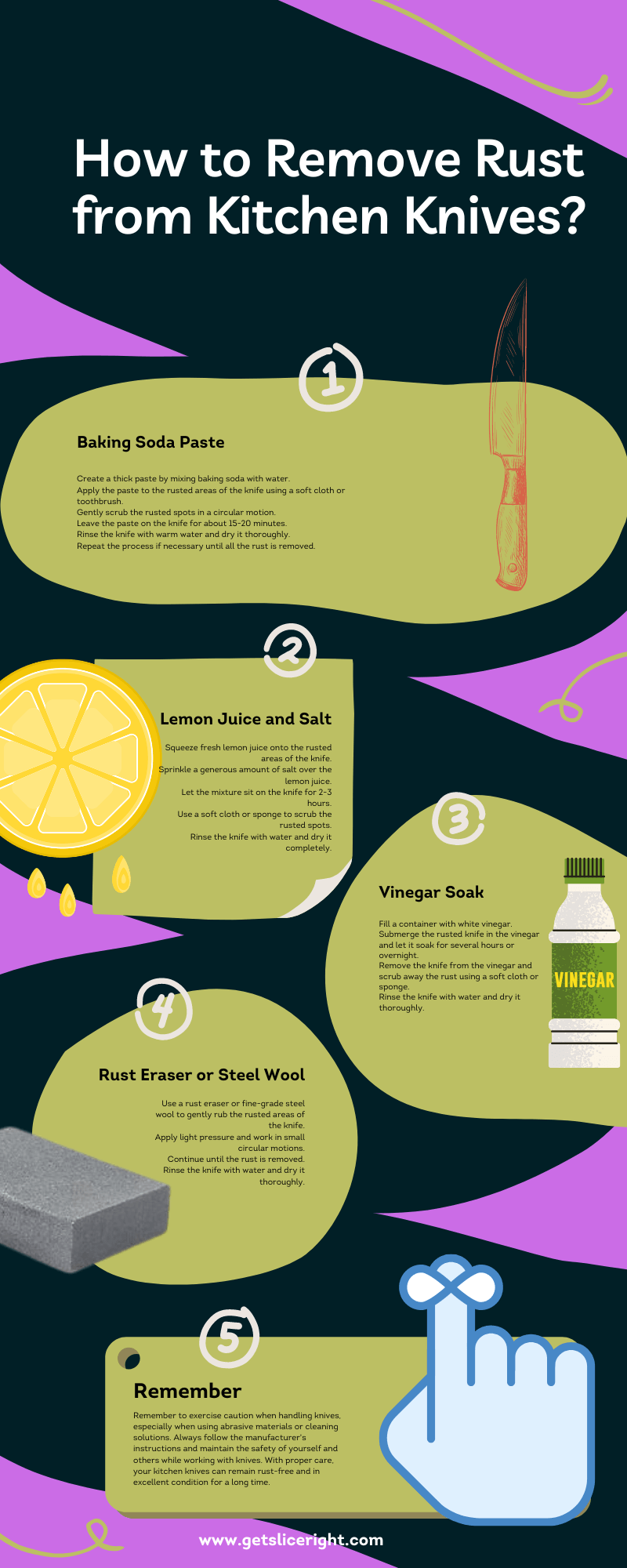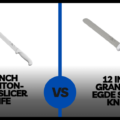Rust on kitchen knives is a common problem that many people face. This pesky, reddish-brown substance can make your knives look unsightly and even affect their performance. Fortunately, several ways exist to remove rust and keep your knives in top-notch condition. Mostly used methods are baking soda and water, vinegar, lemon juice, salt, and steel wool. Restoring your knives back to their former glory is easy with the right tools and techniques.
Why Rust Forms On Kitchen Knives?
Rust forms when iron reacts with oxygen and moisture in the air. This reaction creates iron oxide, the rust you see on your knives. Kitchen knives are particularly susceptible to rust because they frequently come into contact with water and acidic foods, which can speed up the oxidation process.
Is There Rust Resistance Knives?
Not all kitchen knives are created equal when it comes to rust resistance. Stainless steel knives are more rust-resistant because they contain chromium, which forms a protective oxide layer on the surface. However, stainless steel knives can still develop rust if not properly cared for. Carbon steel knives, conversely, are more prone to rust due to their higher iron content.
How To Remove Rust From Kitchen Knives?
Method 1: Baking Soda and Water
- Preparing the Mixture: Mix equal parts of baking soda and water to create a thick paste. You can adjust the proportions as needed to achieve the desired consistency.
- Applying the Mixture: Spread the baking soda paste evenly over the rusty areas of the knife using a soft cloth or an old toothbrush. Let the paste sit on the knife for 10-15 minutes.
- Cleaning and Drying the Knife: After the paste has had time to work its magic, gently scrub the rust away with a soft cloth or an old toothbrush. Be sure to work in a circular motion to prevent scratching the knife’s surface. Once the rust is removed, rinse the knife thoroughly with warm water and dry it immediately using a soft, clean cloth.
Method 2: Using Vinegar
Vinegar and lemon juice contain acidic compounds that effectively remove rust from kitchen knives. Soak the blade in vinegar or lemon juice for a few hours, then use steel wool to scrub the rust.
Method 3: Lemon Juice And Salt
- Preparing the Lemon-Salt Mixture: Sprinkle a generous amount of salt over the rusty areas of the knife. Cut a lemon in half and squeeze the juice over the salt-covered knife, covering all the rusty spots.
- Apply the Mixture: Let the lemon juice and salt mixture sit on the knife for 5-10 minutes. The acidic nature of the lemon juice will help break down the rust, while the salt acts as a gentle abrasive.
- Clean the Knife: Use the lemon half as a scrubber to gently remove the rust from the knife, working in a circular motion. Rinse the knife thoroughly with warm water and dry it immediately using a soft, clean cloth.
Method 4: Potato And Dish Soap
- Prepare the Mixture: Cut a potato in half and apply a small amount of dish soap to the cut surface. The potato contains oxalic acid, which helps break down rust, while the dish soap helps to lift it away.
- Apply Mixture: Rub the soapy potato half over the rusty areas of the knife, applying gentle pressure. Allow the potato and dish soap mixture to sit on the knife for 10-15 minutes.
- Dry the Knife: After the mixture has had time to work, gently scrub the rust and use a soft cloth or an old toothbrush. Rinse the knife thoroughly with warm water and dry it immediately using a soft, clean cloth.
Method 5: Fine Steel Wool
- Gently Scrub the Knife: Dip the steel wool in water and gently scrub the rusty areas of the knife, working in a circular motion. Be careful not to apply too much pressure, which may cause scratches.
- Wash the Knife: After removing the rust, rinse the knife thoroughly with warm water and dry it immediately using a soft, clean cloth.
How To Use Dalstrong Rust Eraser For Removing Rust On Knives?
Step 1. Start by prepping the knife’s blade with a kitchen cloth and cleaning solution, removing any debris or food buildup from the surface.
Step 2. Once the blade is clean, dampen an abrasive pad with water and apply the Dalstrong rust eraser liberally over the entire surface of the knife. Make sure to reach all of the corners and crevices on the blade.
Step 3. Once you’ve applied the rust eraser, begin scrubbing in a circular motion over the surface of the knife with medium pressure. Focus on areas that contain heavy rust buildup or discoloration.
Step 4. Continue scrubbing until you achieve the desired results.
Step 5. Once scrubbing, rinse off the blade with water and dry it thoroughly with a kitchen cloth.
Step 7. For best results, apply oil to the knife’s blade after cleaning. This will help prevent future rust buildup and keep your knives in top condition.
Preventing Your Knife From Rust And Damage
- Regular Cleaning and Drying: Clean your knives with warm, soapy water after each use, and dry them immediately with a soft cloth to prevent moisture from sitting on the surface.
- Proper Storage: Store your knives in a knife block, on a magnetic strip, or in a protective sheath to keep them away from moisture and to prevent contact with other metal objects that can cause scratches.
- Regular Sharpening: Keep your knives sharp, as a sharp knife is less likely to develop rust. Sharpen your knives regularly using a sharpening stone, honing rod, or knife sharpener. A well-maintained edge will help prevent the buildup of food particles that can contribute to rust formation.
- Avoid salty water: Salt can build up rust on kitchen knives. To prevent this, avoid leaving your knives in salty water or exposed to salt air for long periods of time. Instead, rinse them quickly and dry them off immediately after use.
- Don’t store your knives in your utensil drawer: Keeping them away from other utensils is important and not tightly packed. Doing so will prevent them from getting scratched and rust spots caused by metal-on-metal contact.
- Cut on cutting boards only: Using cutting boards minimizes the wear and tear your knives experience, which can help prevent rusting. It also makes it easier to clean up any small bits of food that may have gotten stuck on the blade after use.
- Don’t leave knives in the kitchen sink: For extended periods of time, as this will increase the chance of rust. It is best to store your knives in a knife block or magnetic board and avoid moisture. If you do find yourself with a rusty kitchen knife, there are several ways to remove the rust.
Why You Should Avoid Putting Kitchen Knives In Dishwashers?
Although many modern kitchen knives are labeled as dishwasher-safe, it is highly recommended that you avoid washing your knives in the dishwasher. There are several reasons why hand washing is the better option for maintaining the longevity and performance of your kitchen knives.
- Potential for Damage: When knives are placed in a dishwasher, they can come into contact with other utensils, cookware, and dishes during the washing cycle. This can lead to scratches, nicks, and even chips on your knife’s blade, affecting its sharpness and overall performance.
- Risk of Rust: Rust forms on knives when iron reacts with oxygen and moisture. The high heat and humidity inside a dishwasher create an environment that can promote rust formation, especially if the knives are left in the dishwasher for an extended period after the cycle.
- Dulling of the Blade: The harsh detergents and high water pressure used in dishwashers can contribute to dulling your knives’ blades over time. A sharp knife is more efficient, safer, and less likely to develop rust.
- Handle Damage: Some knife handles, particularly wood or other natural materials, can be damaged by high temperatures and prolonged dishwasher water exposure. This can cause the handles to warp, crack, or become loose over time, making the knife uncomfortable or unsafe.
How To Properly Handwash Kitchen Knives?
To properly clean and maintain your kitchen knives, follow these steps:
Step 1: Fill your sink with warm, soapy water. Use a mild dish soap that doesn’t contain harsh chemicals or abrasives.
Step 2: Hold the knife by its handle and gently wash the blade using a soft sponge or dishcloth. Be sure to clean both sides of the blade and the handle to remove any food particles or residues.
Step 3: Rinse the knife thoroughly under warm running water to remove all soap residue.
Step 4: Dry the knife immediately using a soft, clean cloth. Be sure to dry the blade and handle thoroughly to prevent any moisture from remaining on the knife, which can contribute to rust formation.
FAQs
What’s the difference between rust and corrosion?
Rust is a type of corrosion that occurs when iron and oxygen mix in the presence of water or moisture. Corrosion can occur with metals like aluminum or copper, but rust specifically happens to iron-based products.
How often should I clean and dry my kitchen knives to prevent rust?
Ideally, you should clean and dry your knives immediately after each use to minimize the risk of rust formation.
What are the three main chef knives?
- The most common knives that are found in kitchens are the chef knife, the paring knife, and the utility knife. The chef knife is a large, strong blade for slicing and chopping vegetables, meats, fruits, and other food items.
- The paring knife has a small blade which is great for peeling, coring, and trimming.
- The utility knife is mid-sized and can be used for various cutting tasks, such as slicing bread or carving meats.
What is a cleaver?
A cleaver is a large knife used for chopping and breaking down harder cuts of meat. It has a heavy blade with a sharp edge on one side and a dull backside, which helps pound the meat or make thin slices. The handle can be made from wood, plastic, or metal. Cleavers are essential in any kitchen and perfect for many cutting tasks.
What is a rice knife?
A rice knife is a saw-toothed blade usually attached to a wooden handle.
Conclusion

Removing rust from kitchen knives is simple and straightforward when using the right methods. You can easily restore your knives to their original rust-free condition by trying the techniques properly. Regular cleaning, drying, proper storage, and sharpening are essential for maintaining rust-free knives and ensuring their longevity.

Mario Batali is a renowned author, food enthusiast, and passionate chef who has dedicated his life to exploring the world of culinary arts. With a love for sharing his knowledge and experiences, Mario has become a prominent figure in the food blogging community, inspiring countless readers with his creativity and expertise.
In addition to his culinary prowess, Mario Batali is also a talented writer with a flair for engaging storytelling. He launched his own food blog to share his recipes, cooking tips, and personal experiences in the kitchen. Over time, Mario’s blog gained a loyal following of food enthusiasts who appreciate his unique approach to cooking and his dedication to using only the finest ingredients.
Mario Batali’s passion for food and his commitment to sharing his knowledge with others have made him a true inspiration in the world of culinary arts. Through his blog, cookbooks, and public appearances, Mario continues to spread his love of food and the joy of cooking with his ever-growing fanbase.







